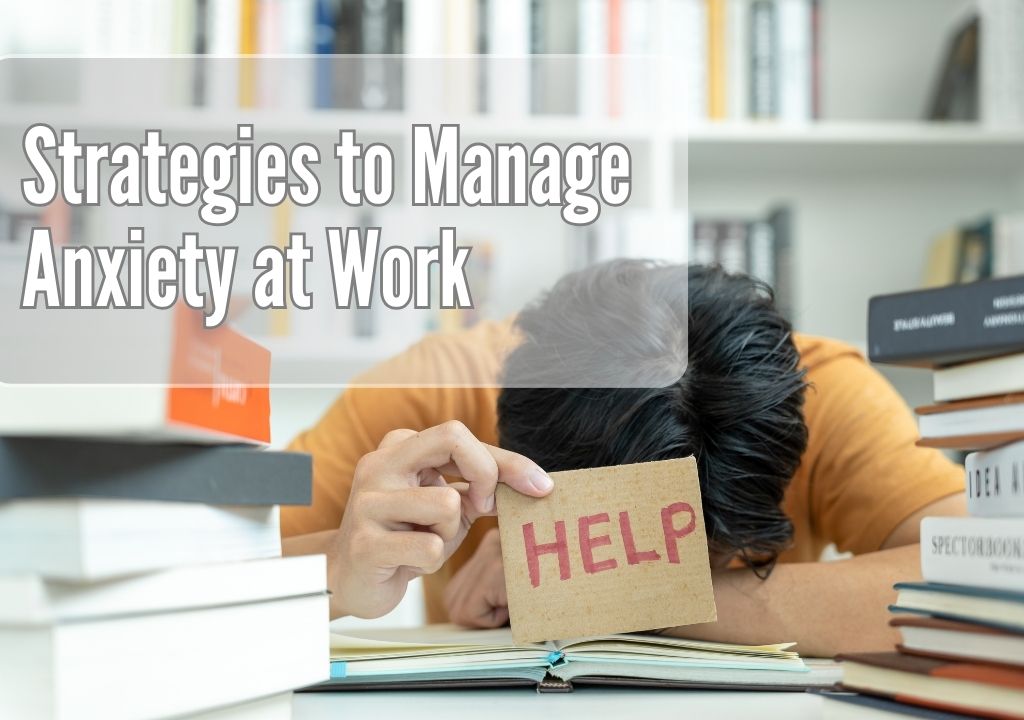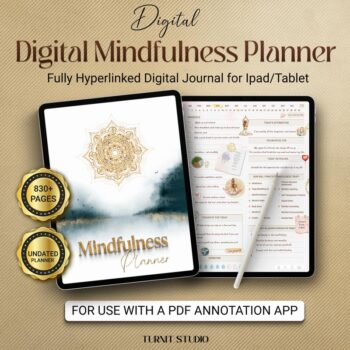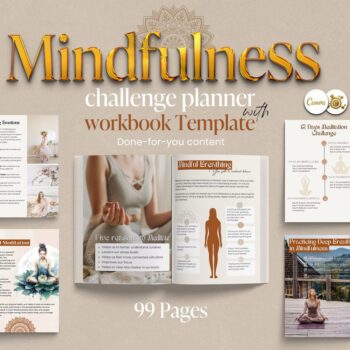Blog
Strategies to Manage Anxiety at Work

In today’s fast-paced world, stress has become an inevitable part of our daily lives, particularly in the workplace. The constant changes in technology, economic fluctuations, and increasing demands from employers have contributed to a rise in stress levels among employees globally.
As a result, many individuals find themselves struggling to manage anxiety at work, especially during important meetings or decision-making sessions. However, by understanding the root causes of anxiety and implementing effective strategies to manage it, we can enhance our job performance and overall well-being.
IN THIS ARTICLE
Understanding Anxiety at Work
Anxiety at work can manifest in various forms, including feelings of apprehension, nervousness, or worry about upcoming tasks, deadlines, or interactions with colleagues. It can stem from a fear of failure, perfectionism, or the pressure to meet high expectations set by oneself or others.
Additionally, anxiety may be exacerbated by external factors such as workplace culture, job insecurity, or conflict with coworkers. Regardless of its source, unchecked anxiety can significantly impact job performance, productivity, and mental health.
Exploring Strategies to Manage Anxiety
1- Mindfulness Techniques
Incorporating mindfulness practices into daily routines can help individuals cultivate awareness of their thoughts, emotions, and bodily sensations. Mindfulness techniques such as deep breathing exercises, meditation, and progressive muscle relaxation can promote relaxation, reduce stress levels, and enhance overall resilience to workplace challenges.
Meditation practices provide a structured framework for cultivating mindfulness and inner peace. Whether through guided meditation sessions, mindfulness apps, or silent meditation practices, individuals can carve out dedicated time each day to quiet the mind, observe their thoughts without judgment, and cultivate a sense of inner stillness.
Through consistent meditation practice, individuals can develop greater emotional resilience, improved focus, and enhanced clarity of mind, empowering them to navigate work-related challenges with equanimity and poise.
2- Stress Management Workshops
Participating in stress management workshops or training programs can provide individuals with practical tools and strategies for coping with anxiety at work. These workshops may cover topics such as time management, assertiveness training, and stress reduction techniques tailored to the demands of the modern workplace.
Time management is a key focus area in many stress management workshops, as poor time management can contribute significantly to feelings of overwhelm and anxiety in the workplace.
Participants learn how to prioritize tasks, set realistic goals, and allocate their time effectively to maximize productivity and minimize stress. By developing efficient time management habits and learning to balance competing demands, individuals can reduce the risk of feeling overwhelmed and increase their sense of control over their workload.
Assertiveness training is another common component of stress management workshops, as assertive communication skills are essential for setting boundaries, expressing needs and concerns, and advocating for oneself in the workplace. Participants learn how to assertively assert themselves, say no when necessary, and communicate their preferences and boundaries effectively, thereby reducing interpersonal conflicts and minimizing sources of stress and anxiety.
3- Using Planners and Journals
Planners and journals can be effective tools for managing anxiety at work by helping individuals organize their thoughts, tasks, and goals. By creating structured plans and schedules, individuals can reduce feelings of overwhelm and increase productivity. Additionally, journaling can provide a creative outlet for expressing emotions, processing stressful events, and gaining insight into triggers and patterns of anxiety.
When choosing a planner or journal for anxiety management, consider options such as mindfulness planners, anxiety journals, or self-care planners. These specialized tools often include prompts, exercises, and guided mindfulness activities designed to promote self-awareness, relaxation, and stress reduction. Incorporating regular journaling and planning sessions into your daily routine can foster a sense of control and empowerment, ultimately enhancing your ability to cope with anxiety at work.
4- Physical Exercise
Regular physical exercise is a powerful antidote to workplace anxiety, offering numerous mental health benefits that contribute to overall well-being. When individuals engage in physical activity, their bodies release endorphins, neurotransmitters often referred to as “feel-good” hormones.
These endorphins act as natural painkillers and mood elevators, helping to alleviate stress, anxiety, and depression. Moreover, exercise stimulates the production of serotonin and dopamine, neurotransmitters associated with feelings of happiness, pleasure, and relaxation. By incorporating activities such as walking, jogging, or yoga into their daily routines, individuals can capitalize on these natural mood-enhancing effects and cultivate a greater sense of emotional resilience.
We know physical exercise provides a healthy outlet for stress and tension, allowing individuals to release pent-up energy and clear their minds. Engaging in aerobic activities, such as running or cycling, promotes cardiovascular health and increases blood flow to the brain, enhancing cognitive function and mental clarity.
Additionally, activities like yoga and tai chi emphasize mindfulness and breath awareness, fostering a sense of inner calm and tranquility. Regular exercise not only helps individuals manage anxiety symptoms in the moment but also contributes to long-term mental resilience and emotional well-being. By prioritizing physical activity as part of their self-care routine, individuals can effectively combat workplace stress and cultivate a healthier work-life balance.
5- Professional Counseling
Seeking support from a licensed mental health professional can be a crucial step for individuals grappling with anxiety in the workplace. Professional counseling offers a confidential and supportive environment where individuals can openly discuss their concerns, fears, and challenges related to work-related stressors.
Through individual counseling sessions, individuals have the opportunity to explore the underlying causes of their anxiety, identify maladaptive thought patterns or behaviors contributing to their distress, and develop effective coping strategies to manage their symptoms more effectively.
One widely used and evidence-based approach in counseling for anxiety is cognitive-behavioral therapy (CBT). CBT focuses on identifying and challenging negative thought patterns and beliefs that contribute to anxiety while teaching individuals practical skills to cope with stress and uncertainty. By learning to recognize and reframe irrational thoughts, individuals can gain a greater sense of control over their anxiety and develop more adaptive ways of responding to workplace stressors.
Additionally, CBT often incorporates behavioral techniques such as relaxation training, exposure therapy, and problem-solving skills to help individuals gradually confront and overcome their fears and anxieties in the workplace. With the guidance and support of a skilled therapist, individuals can develop the insight, resilience, and confidence needed to navigate workplace challenges more effectively and regain a sense of balance and well-being in their professional lives.
6- Time Management Strategies
Effective time management is essential for mitigating stress and anxiety in the workplace. By implementing proven time management strategies, individuals can better organize their tasks, allocate resources efficiently, and meet deadlines with confidence. One key aspect of time management is prioritizing tasks based on their urgency and importance.
By identifying high-priority tasks and tackling them first, individuals can address critical responsibilities promptly and prevent them from snowballing into overwhelming challenges. Additionally, setting realistic goals and deadlines helps individuals maintain a sense of focus and motivation while avoiding the pitfalls of perfectionism or procrastination.
Breaking projects into manageable steps is another effective time management strategy for reducing anxiety at work. Complex tasks can seem daunting when viewed as a whole, leading to feelings of paralysis or avoidance. However, by breaking projects down into smaller, more achievable tasks, individuals can approach their work incrementally and make steady progress over time.
This approach not only enhances productivity but also alleviates feelings of overwhelm and uncertainty. Moreover, breaking tasks into smaller steps enables individuals to track their progress more effectively, celebrate milestones along the way, and maintain momentum toward their goals. By adopting these time management strategies, individuals can cultivate a more balanced and productive approach to work, reducing stress and anxiety while maximizing their effectiveness and job satisfaction.
The Significance of Planners and Journals in Anxiety Management
Planners and journals serve as effective tools in managing anxiety by providing a structured framework for organizing thoughts, setting priorities, and monitoring progress. In the context of work-related anxiety, individuals often experience a myriad of stressors such as tight deadlines, high expectations, and interpersonal conflicts.
These stressors can trigger feelings of overwhelm and uncertainty, making it challenging to stay focused and productive. However, by utilizing planners and journals tailored to anxiety management, individuals can adopt proactive strategies to address these challenges.
Digital Mindfulness Planner
Digital Mindfulness Planner for iPad, GoodNotes, Healing Anxiety and Self Care
Anxiety planners and journals typically include prompts, exercises, and guided activities designed to promote self-awareness, relaxation, and stress reduction. These tools encourage individuals to identify and challenge negative thought patterns, practice mindfulness techniques, and develop coping mechanisms for handling stressful situations.
By engaging with their planners and journals regularly, individuals can cultivate a greater sense of control over their thoughts and emotions, allowing them to approach work-related tasks with confidence and resilience. Moreover, the act of journaling provides a cathartic outlet for expressing emotions and processing difficult experiences, thereby alleviating pent-up stress and tension.
Choosing the Right Planner
When selecting a planner, consider your unique needs and preferences. If you thrive on the tactile experience of writing by hand, opt for a traditional paper planner with ample space for jotting down thoughts and ideas. Alternatively, if you prefer the convenience of digital tools, explore apps that offer customizable layouts and interactive features.
Look for planners that strike a balance between structure and flexibility, allowing you to organize your tasks while accommodating unexpected changes and adjustments. Additionally, prioritize planners that incorporate sections dedicated to self-care practices such as gratitude journaling, mindfulness exercises, and daily affirmations. These features can serve as gentle reminders to prioritize your well-being amidst the demands of a busy workday.
Plus, be open to trying out different planners until you discover the one that truly connects with you. What works for one person may not necessarily work for another, so trust your intuition and adapt as needed. Remember that the goal of using a planner is not perfection but progress. By incorporating planner usage into your daily routine and embracing its potential as a tool for anxiety management, you can take meaningful steps towards achieving a greater sense of balance and fulfillment in both your professional and personal life.
The Importance of Consistency
Mindfulness Journal Canva Template – Mindfulness Workbook
99 pages Mindfulness Journal Templates and Workbook with Done for You content, Mindfulness Journal Canva Templates contain with Mental Health Planner, Challenge Planner, Wellness Planner Journal, and Coach Template with Commercial Use
Incorporating planners and journals into a regular routine not only enhances organization but also fosters a sense of accountability and self-awareness. Consistent utilization encourages individuals to become more attuned to their thoughts, emotions, and productivity patterns, empowering them to identify triggers of anxiety and implement effective coping strategies.
Moreover, the act of planning itself can serve as a therapeutic outlet, providing individuals with a structured way to express their concerns, set intentions, and visualize their path forward. By dedicating time to plan and reflect regularly, individuals can cultivate resilience and confidence in their ability to navigate workplace challenges with greater ease and resilience.
Utilizing Planners and Journals for Anxiety Management
In anxiety management, planners and journals emerge as invaluable companions, aiding individuals in their journey of self-discovery and resilience building. These tools provide a structured framework for individuals to delve into their inner thoughts and emotions, enabling them to pinpoint anxiety triggers and patterns.
By logging their experiences and reactions, individuals can gain deeper insights into the root causes of their anxiety, empowering them to address these issues more effectively. Moreover, the act of journaling itself can be therapeutic, offering a cathartic outlet for expressing emotions and releasing pent-up stress.
A mindfulness planner, specifically designed to foster present-moment awareness and emotional balance, offer a variety of exercises and prompts aimed at cultivating mindfulness skills. Through practices like mindful breathing, body scans, and gratitude journaling, individuals can learn to navigate their thoughts and sensations with greater ease, reducing the impact of stressors on their mental well-being.
Similarly, self-care planners emphasize the importance of prioritizing one’s physical and emotional needs amidst the demands of daily life. By incorporating activities that promote relaxation, enjoyment, and self-compassion into their schedules, individuals can establish healthier habits and better cope with the pressures of work and life.
Practical Tips for Effective Planner Use
To maximize the benefits of planners and journals for anxiety management, consider the following tips:
Set aside dedicated time each day or week for planning and reflection: Designate specific times in your schedule for planning sessions where you can review tasks, set goals, and strategize for the day or week ahead. Additionally, allocate time for reflection to assess your progress, identify areas for improvement, and celebrate achievements.
- Use color-coding or symbols to categorize tasks and prioritize activities: Implement a color-coded system or symbols to visually differentiate between different types of tasks, such as work-related projects, personal errands, or self-care activities. This technique helps you prioritize tasks more effectively and allocate time and energy to high-priority items.
Incorporate positive affirmations or motivational quotes into your planner: Infuse your planner with uplifting messages or inspiring quotes that resonate with you. These affirmations can serve as gentle reminders to stay focused, motivated, and resilient, especially during challenging times at work.
FAQ
How can I tell if I'm experiencing anxiety at work?
Anxiety at work can manifest as persistent worry, difficulty concentrating, irritability, and physical symptoms like rapid heartbeat or sweating. If you notice these symptoms affecting your daily functioning, it may indicate anxiety.
What are some common triggers for anxiety in the workplace?
Common triggers include tight deadlines, performance evaluations, conflicts with colleagues or supervisors, uncertainty about job security, and overwhelming workloads.
How can I manage anxiety during important meetings or presentations?
Practice relaxation techniques such as deep breathing or visualization beforehand. Prepare thoroughly, break down tasks into smaller steps, and focus on delivering your message rather than worrying about outcomes.
Are planners and journals effective tools for managing anxiety at work?
Yes, planners and journals provide structure and organization, helping individuals prioritize tasks, set achievable goals, and track progress. They also offer a space for reflection and self-awareness, which can aid in managing anxiety.
What types of planners are best for managing anxiety at work?
Mindfulness planners focus on present-moment awareness and stress reduction techniques. Self-care planners incorporate activities to promote well-being, while goal-setting journals help individuals track progress towards specific objectives.
How often should I use my planner or journal to manage anxiety effectively?
Consistency is key. Aim to use your planner or journal daily to set intentions, track tasks, and reflect on achievements. Regular use helps establish routines and reinforces positive habits for managing anxiety.
Can physical exercise help reduce anxiety levels at work?
Yes, regular exercise releases endorphins, neurotransmitters that improve mood and reduce stress. Aim for at least 30 minutes of moderate exercise most days of the week to experience the benefits.
What are some practical time management strategies for reducing workplace anxiety?
Prioritize tasks based on urgency and importance, break large projects into smaller, manageable tasks, and use techniques like the Pomodoro Technique to stay focused and productive.
Should I seek professional help for managing anxiety at work?
If anxiety significantly impacts your ability to function at work or affects your overall well-being, consider seeking support from a therapist or counselor. They can provide coping strategies, therapy, and support tailored to your needs.
How can I create a supportive work environment for managing anxiety?
Encourage open communication, foster a culture of empathy and understanding, provide resources for stress management and mental health support, and promote work-life balance to create a supportive workplace environment.
Conclusion
Managing anxiety at work is essential for maintaining well-being, productivity, and job satisfaction. By implementing a combination of strategies such as mindfulness techniques, stress management workshops, physical exercise, professional counseling, time management techniques, and utilizing planners and journals, individuals can effectively cope with workplace stressors and navigate challenges with greater resilience and confidence. It’s essential to prioritize self-care, seek support when needed, and cultivate a healthy work-life balance to thrive in today’s fast-paced work environment. With the right strategies in place, individuals can create a work environment that promotes well-being, productivity, and overall job satisfaction.
Digital Mindfulness Planner
Digital Mindfulness Planner for iPad, GoodNotes, Healing Anxiety and Self Care


